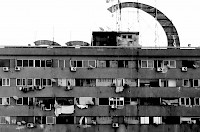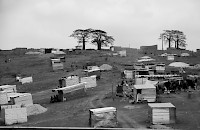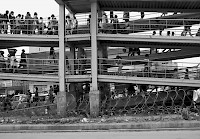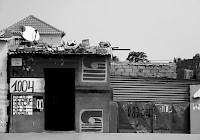Architecture can be regarded as media. On the one hand it frames reality (seen through its windows, doors and thresholds reality is cropped, as in a photograph). On the other hand, architecture is a container of time. In this sense it has filmic qualities: it gathers a succession of moments, narratives, temporalities, which it superimposes, rewinds and finally produces. In a house, time accumulates, and can be accessed by the physical marks it leaves, or by memory.
In this sense, making documentary photography of architecture can be redundant, as architecture itself is a medium that documents reality. The images shot by the Angolan photographer Delio Jasse in Luanda, mostly of modernist architecture built between 1950 and 1975, can be considered in relation to archival images from the epoch in which these were built. In the following interview they will be also reviewed in connection to other practices and preoccupations of Jasse, and placed in the context of the Lisbon BES Photo exhibition – a prestigious prize for which Jasse has been nominated in May this year.
Permanent Absence, the series of 9 large scale photographs that constitute his BES Prize show, opened on May 28th 2014 in Museu Coleccao Berardo in Lisbon, functions as a double palimpsest: on the one hand the image series merges all his persistent preoccupations articulated in his work to date, and on the other hand it layers three types of photographic information: architecture, anonymous portraits and imprint into one polymorphic image. The resulting visual record represents for Jasse 'a uniform coating that permits a simultaneous reading of different sources'. The large-scale analogue prints are installed sculpturally in the exhibition space, and can be approached from various perspectives.
Jasse works with architectural transformation in Luanda: extended from the last decades of 'modernist' colonial architecture, now seriously decayed and partially demolished, to the massive new construction sites and improvised housing lots.
Recently systematic research has been invested in the slowly disappearing architectural heritage, erected during the Estado Novo in Luanda. A great collection of photographic documents of the 1950-1975 epoch can be consulted on the archive Modernidade Ignorada (http://www.modernidadignorada.com/). These architectural documents, shot in the epoch of their building, show colonial architecture playing out its formal purity and the aspirations of the 'style' – in a phase in which deterioration had not yet installed.
Delio Jasse's constant return to this architecture makes a counter-statement to genuine photographic documents. Without insisting on details of contingent daily life, Jasse, nevertheless, integrates an organic dimension to the aspired formalism of the architectural style. His images catch the enduring classicism of this architecture, and the importance conferred upon it in the cultural landscape in Angola, for catalysing the model of 'modernism'. But, at the same time, by superimposing images of buildings that have already disappeared with buildings in construction or ruined ones, Delio Jasse's photos transport a type of fictional information, which holds both the prospective and regressive character of these colonial buildings. In Jasse’s images, the accurately documented architectural forms, extracted from the immediacy of the 'real', glide between their projected past that never materialised into a 'modernist' future, and a lived present that carries the reality of these unaccomplished plans. It is precisely in this aspect of 'reality' taking over the utopia of modernism, that Paula Nascimento recognizes1 the value of the Luandan hybrid neighbourhoods: a 'morphing space' in which a mix between the centre and the periphery, the formal and informal way of life, was for the first time generated by this modernist architecture in Angola.
This so-called 'rationalist' architecture was developed within the framework of colonial urban plans, usually designed in Lisbon during the Estado Novo regime, the dictate of Antonio de Oliveira Salazar. It was developed by architects working for the Ministry of Colonies (later called Ministerio do Ultramar – The Ministry of the Overseas).2 Some examples of this particular style, which tuned European modernism into the climatic and social local necessities, are still standing, while others are presently in a serious state of decay – destroyed by lack of maintenance and a succession of wars after the liberation from Portuguese rule.
In Ignored Modernity: The case of Luanda3, Paula Nascimento explains that during the Estado Novo, Angola was on the one hand subjected to the repressive state authority, while on the other, it gained a zone of liberty, being at a distance from the ruling center. In architectural terms, this was an opportunity to break away from the ideological constraints designed in Lisbon and to turn towards an international style and to Brazilian models (more adaptable due to similar tropical conditions). In this way, Angola became a platform for experimentation in architecture, both on a formal and an ideological level.
For the architects working in Angola, the main point was the attempt at the democratization of urban space, by integrating citizens of different classes into a unitary urban fabric. The Angolan-born architect Fernao Simões de Carvalho, who had worked under Le Corbusier, introduced traditional irregular structures into the city and integrated suburbs. His architectural solutions created a distance from the ideology practiced in Lisbon by adopting sun parapets, balconies and terraces, and the openness of the facades4 , but also by trespassing the borders between Angolan and European styles of living. Many of these buildings were never finished (like for example a sort of Unite d' Habitation designed by Simões de Carvalho in Bairro da Prenda), or are in a state of decay due to bad maintenance caused by the Angolan War of Independence, followed by almost 20 years of civil war. A lot of edifices are already demolished, for example the CUCA, an apartment block built by Luís Taquelím da Silva, and the Kinaxixi Market by Vieira da Costa, which are a constant presence in Delio Jasse's images.
I met Delio Jasse in Lisbon in March and we talked about these demolitions, that had generated controversies among Angolan scholars and city dwellers alike. The notion of urban modernity is arduously debated in connection to the colonial, modernist architectural past: Is this heritage still needed? To what degree did the urban lifestyle deviate from this 'projected modernity'? Was the fall of so many buildings not a direct consequence of that?
Q: The layering of documentary material in your images follows the layerings of the city itself and the amalgam of architectural information.
D.J.: After spending 12 years in Portugal, I returned in Angola in 2010. Ever since, I have been watching regularly the process of urban growth in Luanda and the change in the scale of the city. The 1940s and 50s colonial buildings, which constitute now a national architectonic heritage, are being replaced with a growing infrastructure of over-sized buildings, many of them with layers of elevated platforms (like airplane landing strips) on top. This is a centre of Luanda phenomenon, whereas in the outskirts housing is made of tin. In my images, I document by repeatedly showing certain architectonic structures, or by magnifying certain details, such as water towers and water tanks in the landscape, to bring attention to the water supply problems in Angola, and to point to the existence of resources, that need to be exploited and put to use. Industrial constructions like these are universal and I constantly work on historic correspondences between architectonic styles and forms. I also work with the image of railways, which started operating in Angola five years ago. Before then the country was practically never traversed, due to a succession of civil wars: you could just see people walking in between the non-functioning tracks.
Q.: Your particular way of working with the documentation of architecture, is in assessing issues of urbanism and urban policy in Angola, rather than focusing on architectural style, although you closely record the buildings themselves.
D.J.: For me, it is very important to point out the necessity of having new buildings constructed outside of Luanda, instead of clustering new construction in the center for economic reasons. The city is growing, but the center is marked by an infernal traffic and the new buildings are not integrated. I have photographed for example the new National Assembly building, built by the Portuguese company Teixeira Duarte Engenharia – a copy of mixed historic European styles with a very weak structure, made with extremely poor materials, not using even stone or marble, which are abundant in Angola. The new building, located in the Kinanga neighbourhood, in Samba, Luanda, at a cost of US$185 million, is part of a complex made up of three buildings. It reflects neither the local necessities, nor historic architecture, and it is impossible to identify with such a building that should represent the citizens’ interests.
Q.: What do you consider to be a national architectonic style in Luanda? Is there an explicit formal language, belonging to a certain period, which could be considered as such?
D.J.: The local adaptation of the Portuguese architectonic style, built in Angola during the 50s before the War of Independence, is the most commonly encountered style. Marble, in which Angola is rich, is commonly used in this style, framing the doors and windows. The proportions of the National Assembly in Luanda, with its unjustifiably high costs, reflect neither Portuguese architecture, nor the local interpretations of modernism practiced in Angola during the 50s. The recent architecture in Luanda attests to no principle, no sequence, no common denominator or architectonic direction. The majority of work is done by commissioning Chinese architects, that do not relate to the historical background.
Q.: What is the everyday life of these buildings, and in what way did gentrification happen?
D.J.: The common phenomena of making room for new buildings by evacuating and demolishing the old city center, means relocating its inhabitants into the suburbs, into what is called social habitation, consisting in Luanda of about 15.000 identical houses. People usually do not have a banking system, which makes them unable to buy the terrains or buildings they live in. They live from day to day, from the things they sell in the markets and on the streets, and keep their money in furniture or behind a book. These new habitation sites for relocated people, are enormous pieces of land, marked by fences and gates, and clusters of prefabricated houses without any infrastructure. I show in my images these low, provisional, unfinished barracks, made in materials that are not resistant to the cold or heat.
New buildings in the center of Luanda are mainly not built for habitation; they function as headquarters of companies. Generally these are built by Chinese architects and workers, who take over large projects from their design to their execution, for example one of the first tall buildings in Luanda, the C.I.F. Tower (115 m high), which was designed and built by the China International Fund. It is anticipated that the center will not be inhabited 15 years from now. In the remaining historic buildings, the main objective of the inhabitants is to resist the given conditions, which are often a lack of basic conditions and of financial resources. One of these has been, until recently, the famous modernist CUCA building, present in my photographs. Instead of being restored, it has been demolished to make place for the largest commercial center in Africa, currently under construction.
Q.: In your images, the theme of mobility is also correlated to architecture: highways, transition areas, masses of cars and people in circulation.
D. J.: For the traffic to reach the city center from the outskirts takes about 4 hours, due to bad access structures. For the citizen relocated to the outskirts it is suddenly almost impossible to reach the city, to reach the places where they used to live. The rest of the buildings in the center of Luanda became priceless. This phenomenon happened in the recent history of Brazil, which has a similar historic modernist architecture, where the living situation was a direct consequence of the fact that until some decades ago there was no middle class, as is now happening in Angola. The architecture has no identity at the moment, as a consequence of this social reality, and the city is built according to personal, not civic, interests. As the city was originally oriented towards the ocean, a scaling in height allowed most of the buildings access to a sea view and to light. The new edifices interfered in this structure, not taking into consideration the building conditions of the ones that had stood there before, and abusing common sense urban principles.
In my images you can also see many people running with masks. They practically hide from the dust generated by the permanent demolition and construction sites in Luanda: without public notification, urban planning, height or material requirements and without respect for the inhabitants. Luanda is full of enormous cranes and scaffolding, disproportionately dominating the city-line, whose heavy presence practically replaces that of architecture. Buildings that reach over 25 stories, on land bought often without a permit, have an accelerated construction time of about 1 year. Buildings suddenly implode, and in the middle of the debris new giants are being implanted.
The series of images that I did last year, 'Desencontro', meaning mis-encounter, describes my experience when going back to Luanda: the impossibility of re-encountering places, my missed encounters with the city, where buildings or places were totally lost.
Q: You work manually and exclusively with analog procedures while composing the image, although the images are digitally printed.
D.J.: In the collection of images that I present for the BES prize, the draft of every image has been obtained by superimposing various types of documents, each one with its own time of exposure. The information extracted from each of these has been manually inserted into this new image. 'Permanent Absence' is technically and conceptually an impression/imprint of different vestiges and of their lingering effects into the present. In the many levels and degrees of the uniformly coated image, the absence of what has been, maintains its own presence.
Q.: Beside your constant attention to urbanism and architecture you work also with documents in the form of official stamps and portrait photography.
D.J.: Stamps are codes for me. We all have them on our identity cards. Marking an image with these stamped numbers, goes back to the nature of any image as a document. And when I stamp a photograph with a certain code, it passes from being an image, to being a document. I work a lot with official photography that itself represents a code in a social and historical sense: old passport portraits, for example, that carry the whole history of immigration policy with them. Some of these stamps intervene on the portrait not only with added text and numbers, but also with a water mark, which affects the materiality of the photography itself. I recreate in my work this type of situation, using my own identity and immigration documents, or retrieved material. I then transfer this information not only onto portrait photography, but also onto other images, for example onto architecture.
Q: It is definitely a violent procedure to apply to the image.
D.J: Images have a lot of force and I actually work with this force.
Q: Yes, an image is forcing reality in a certain direction, like a document that is manipulating reality.
D.J.: I manipulate the images myself. I transpose them into other materials, I juxtapose them etc., circumscribing the idea of document and its discourse.
Contrary to documentary photography that freezes and retains a singular/historic moment, which gains relevance and representativity by being captured at a particular time, in Delio Jasse's images, buildings are not seen as exemplary for the formal purity of colonial architectural style. His interventions on documents extract the architecture from this unique moment in which they were built (the last decades of the colonial rule) – and show them as belonging to a dynamic historic flow. As he follows phenomena such as demolitions, urban migration, construction policy, the buildings in his images appear as traversing different epochs. In this sense, his images are not preserving or canning a distant memory (as documentary architecture photograph normally does), but instead show the transformations of architecture and of their memory. Beyond encapsulating history, architecture has the power to renovate itself in traversing time. Showing Luandan architecture as detached from the particular late colonial style, formulates a strong critical position.
Technically, this is attained by Jasse also by making visible the process of the photo's own making. The images remain open, and show the various layers of treatment, which Jasse applied upon them. Some of his many series of images are shown on film strips. Other series reveal the application of photographic negative emulsion, which creates a reflexive gap in time between the subject and the support. Others consist of many layered images: people, street views, various official stamps.
“I do not consider my photographs to be documentary, even if in most cases my point of departure is a document (for example a portrait or a photo of an existing building). Starting with this document (which I prefer to call a record), I start to experiment with the means of analogue photography, a process in which the record progressively loses its reality, while gaining new elements. I am constantly developing an archive from the past, which, to me, is settled in an indefinite reality, which is neither past nor present, real nor false, it is in-between.”5
Memory is therefore somehow undermined. This new quality that architecture gains in Jasse’s work – of documenting/transmitting its own metamorphosis in time – is somewhat paradoxical, when thinking of the paradigmatic qualities of architecture: stability, permanency, immutability.
Without playing out what could become a picturesque and somewhat exotic dimension of the everyday life of these buildings, but also without reducing them to the formal relevance of their architectural carcasses, in Jasse's images these buildings are conceived relationally, which induces their political force. Not only in relation to time – as traversing certain historic durations – but also affiliated to the people, who appear en passant, always circulating.
Contrary to the documentary images of the epoch6, in which architectural photography is rather a de-populated, self-sufficient formal study, in Delio Jasse's images, the buildings appear as an attainment of the people that inhabit the society reminding us of the fact that architecture is meant to design opportunitieszzz. In the context of colonial architecture, which represented a visual frontispiece of the Empire's ideology, adapting architecture to the exigency of the local community, understood as a powerful social body, was a political project of the above mentioned architects (Simoes de Carvalho or Vieira da Silva). If hegemonic architecture is meant to fix historic meaning and last, the way these buildings have been adapted and altered for non-hierarchical use by the citizens of Luanda with the aid of ephemeral construction materials, points to the value of such adjustments as political counter-statements. With these constructional adjustments comes a more polemic, participative memory that improvised, bricollaged build forms call for, rather than the passive commemoration of a historic monument.
Although accurately documented, the architecture in Jasse's images is shown as fluid, and assiduously challenging the ideology which determined its formal vocabulary in the first place. A definite political power resides in these slow mutations. They point to reciprocal influences between people and public architecture – whether it is for living in or for industrial use. They show the way architecture determines movement, posture, the urban sense of being. By not fixing a certain moment in time, and by not constructing memories, but by layering time and space – they attest how the proportions of architecture in relation to the human being get distorted: architecture seems oversized beside the human – an outcome of the perception of historic transformations in time.
Nevertheless people in Jasse's images are shown in their fluent mobility, as essentially active agents in a long duration of unconfined time that transforms, adapts, and recasts architecture. Industrial, institutional or residential colonial architecture is shown as not being a predestined political form which exercises an inevitable effect upon its dwellers, but as a process that is streaming various type of information – and subject to its own effects. This is, at the same time, a melancholic statement facing the entropy of any type of built form, but also a way to assess the force of the present to generate its own coherence, whether it be social, economic, personal or political. Marta Jecu



